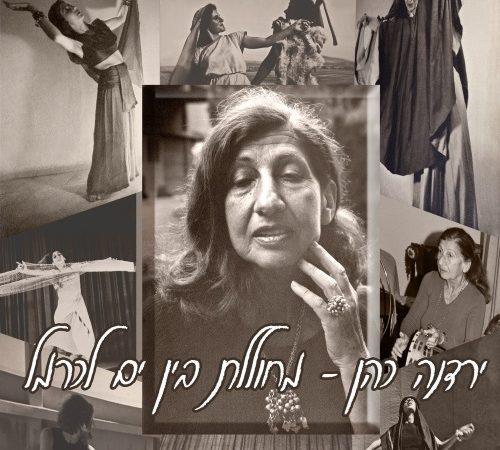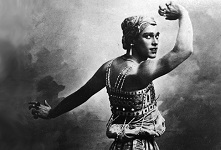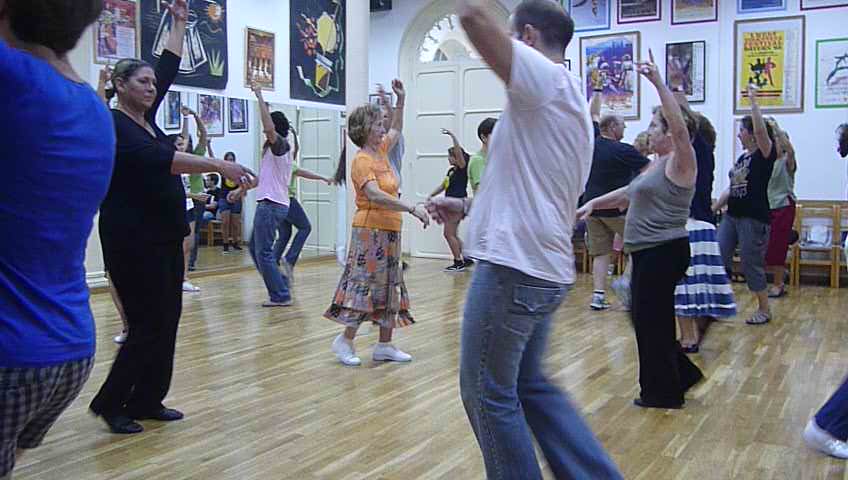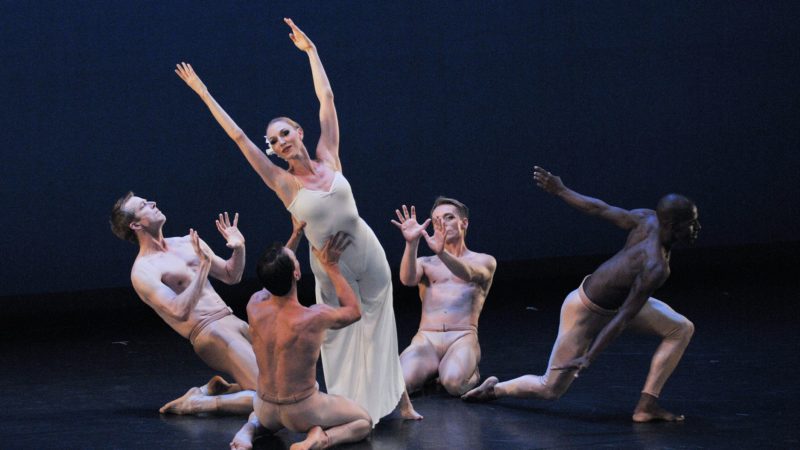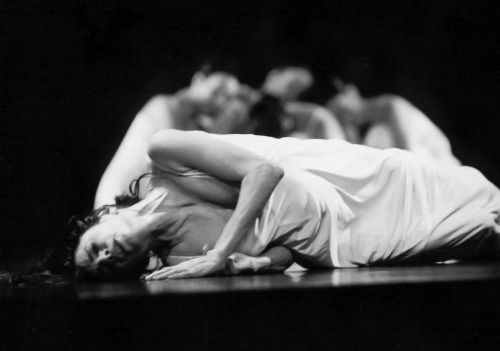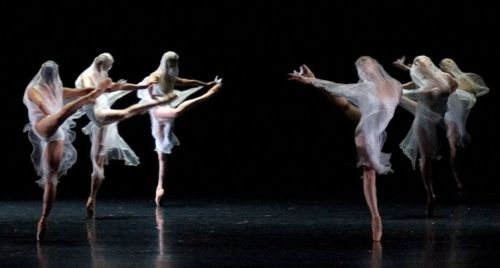The Scope of Relationships between Dance and Painting
The present epoch will perhaps be above all the epoch of space. We are in the epoch of simultaneity: we are in the epoch of juxtaposition, the epoch of the near and far, of the side-by-side, of the dispersed. We are at a moment, I believe, when our experience of the world is less that of a long life developing through time than that of a network that connects points and intersects with its own skein.
Michel Foucault[1]
The interplay of dance and visual art is not a new, previously unknown genre. Its traces go back to ancient cultural societies, between 8,000 and 5,000 BC, when people had painted dancing figures on cave walls. More than 400 examples of painted scenes on pottery and carved stones, from sites in the Balkans and the Middle East, serve as data in Yosef Garfinkel’s research (1998, 2001), interpreting the illustrated record of dancing and examining the special importance of dance as a means of individual self-expression and active participation in ritual, which was also used as a method of depicting the creation of social solidarity.[2] Despite its long history, the characteristics and nature of the relationship between dance and painting has attracted little attention in scholarly literature. Adrian George reasons in her article “The Art of Dance” (2002) that the nature of artist-dancer collaborations is lost because of the way the respective histories of the art forms are recorded.[3] Of the articles that do discuss the issue, most investigate subject matter referring to one art form or only a few aspects of the collaboration. Others are historical studies that examine a critical moment in the history of the relationship dance-painting, offering some insight into its development. Full-length scholarly texts devoted to this matter are scarce.
The extent to which dance and dancers inspire the subjects of art in the early twentieth-century, is the concern of Nancy Van Norman Baer in her essay “The Artist and the Dance” (1983), and of Mario Amaya in his article “The Twenties and After” (1961). Van Norman Baer (1983) argues that a bond between the painter and the dancer is created through the range of visual images of dance as well as the range of artists’ styles, related to movement and expressive purpose. She names this relationship ‘inspiration’ and illustrates it with Henri Matisse’s observation that he wishes to work like a dancer who “begins his day with several hours of loosening-up exercises” (Van Norman Baer, 1983, p. 22).[4] She continues by commenting on Anna Pavlova’s motivation, who said: “I try to express by dancing…what the painter expresses with his colors and brushes” (Van Norman Baer, 1983, p. 22). Van Norman Baer (1983) and Amaya (1961) both argue that painters are interested in dancers’ rhythmic movement, although while Amaya argues that the artist frees himself from any recognisable figure, Van Norman Baer claims that artists pay attention to the position of the dancers’ feet, hands and arms, and particular details of costumes. The most successful works, Baer (1983) argues, are those in which the artist's interpretation is achieved through a response to both the spirit of drama and the personality of the dancer. She illustrates this point with Auguste Renoir’s response to a social milieu in his etching Dancing Couple (1883), Henri de Toulouse Lautrec’s lithograph Miss Ida Heath – Danseuse Anglais, and Michel Georges-Michel’s The Opening of ‘La Parade’.
Horst Koegler, in his article “Choreography and Visual Artists” (1994), addresses ‘choreographed paintings’, in which the choreographer depicts the essence of a painting or paintings in a most straightforward form, signifying the importance of the performer’s role in this process. In this category Koegler also includes the classification of the ‘choreographic re-telling of an artist’s biography’. One of the examples he gives is Glen Tetley’s dance, The Anatomy Lesson (1964), made for the young Nederlands Dans Theater, which attempts to reflect Rembrandt’s portrait Dr. Nicolaes Tulp’s Anatomy Lecture (1632).
Ted Merwin (1998) and Amy Zornitzer (1998), in their articles headlined “Loïe Fuller and the Futurists: Two Views”, examine Fuller’s influence on Filippo Tommasso Marinetti, the founder of Italian Futurism.[5] Merwin and Zornitzer both present the manifesto of the Futurist Dance, printed in 1917, to illustrate how Fuller, a Symbolist dancer, inspired Marinetti.[6] In the manifesto, Marinetti compares Fuller’s work with that of Isadora Duncan and Valerie de Saint-Point, and writes “we Futurists prefer Louie Fuller” (in Zornitzer, 1998, p. 97).[7] The reason was that Fuller, like the Futurists, was “determined to produce the total, harmonized, scintillating theatrical event”, which invested theatrical action with abstract form and colour in space (p. 98). Zornitzer argues further that both Fuller and Marinetti were influenced by scientific and technological inventions that were introduced at the turn of the twentieth century. He claims, however, that the essential difference between the two was Marinetti’s celebration of artistic iconoclasm in contrast to Fuller, who “had no cultural or political agenda: her passion was her art” (1998, p. 88).
Amaya (1961) further explores the element of rhythmic movement and energy in diverse works of fine art, in various artistic movements since the 1920s. One of his examples is the Futurist painter Fernand Léger’s work The Graces (1930), in which he kept the dance’s rhythm, although the shape of the dancers’ ‘pas de deux’ is reduced and generalised (for a further discussion on the relationships between Futurism and dance see chapter 1.3.1).[8] He goes on to demonstrate the movement of the stick figure in The Dance Scene (1938) by Paul Klee, and describes Piet Mondrian’s Broadway Boogie Woogie (1942-43) as the “cold abstractionism of this popular dance music” (1961, p. 16). Amaya talks about Joan Miró, who has “plumbed the depths of his unconscious for the wild, disheveled performer” (1961, p. 16) as illustrated in his Spanish Dancer (1945). On the other hand, he claims, Jackson Pollock’s works “seem to encompass the very essence of the dance with their arabesques, their exciting jetés, their thrust and energy” (p. 18), as seen in Number 32 (1950). Jean Dubuffet, he argues, returns to an expression of man’s existence through the act of dance and artistic creation, as seen in his Danse Brune (1959), through his use of “some vague references to the image” (1961, p. 18).
The attempt of some painters to enter the realm of set, costumes and posters designers for dance productions is also discussed by Van Norman Baer (1983). This allows the production, she argues, to “live beyond the moment of performance” (p. 23). Another aspect of this phenomenon is of artists subjecting themselves to the specific conventions of theatrical dance. One example is a painted three-dimensional stage design, which unlike two-dimensional backdrops, is integrated into the choreography, as seen in Isamu Noguchi’s sets for Martha Graham’s productions. Koegler, who elaborates on this aspect, says that it indicates that the painter strives to “break out of the picture frame and…to conquer another dimension” (1994, p. 16). Van Norman Baer (1983) discerns the importance of artists working as designers for dance in the manner it affects and influences the substance material of the art of dance. It “extends the context of the dancer’s movement in space through means of costume and backdrop, which also establish the mood of a performance” (Van Norman Baer, 1983, p. 23), she argues. In collaborations of that kind, be they Diaghilev’s Ballets Russes, Romantic Ballet or Cunningham’s productions, the theatrical effect becomes greater than individual components. Moreover, it can change the dancer’s movement – as a result of both design and fabric – while also enlivening the choreography.
Koegler (1994) and George (2002) both identify critical moments in the histories of the arts of dance and painting in the twentieth century. Koegler considers these moments in the history of artists designing for dance, which occurs in only few cases, as the “true creative partnership in artistic cooperation” (1994, p. 16). He reasons that only in such cases choreography, space and costumes design had effective influence on each other. The first one was Diaghilev’s Ballet Russes, which had descended on Paris in 1909. According to George,
every part of his ballets – choreography, music, set, costume and lighting – was designed to come together to create a total experience for the audience.
2002, p. 20.
Koegler and George also mention the creative artistic partnerships between Pablo Picasso’s costume design and stage sets for Leonide Massine’s choreography, Parade (1917).[9] George cites Guillaume Apolliniare’s notes in the original programme
Picasso and Massine have consummated for the first time this marriage of painting and dance, of plastic art to mime that is the sign of the accession to the throne of a more complete art.
George, 2002, p. 23.
Another example is the glass spatial sculptures and costumes by Gabo and Pevsner for Balanchine’s La Chatte (1927), which Koegler argues had a “decisive influence on the style of the performance” (1994, p. 16).
A more subtle aspect of the relationship between dance and painting, as Amaya (1961) and Van Norman Baer (1983) both argue, is when the field of dance serves as an experimental canvas, allowing artists to work out their new theories and ideas with more confidence. Amaya (1961) argues that one of the three most important artists to work with Diaghilev, together with Georges Braque and Juan Gris, was Pablo Picasso, who tested his cubist theories in his costume designs for Massine’s Parade (1917). He argues that Picasso, who painted his first fragmented work Les Demoiselles d’Avignon as early as 1907, worked out some of his earlier motifs later that year, as seen in his paintings Dancer (1907) and Negro Dancer (1907). In the four years after Picasso joined Diaghilev, he created the sets for Massine’s Le Tricorne (1919), Pulcinella (1920), and Cuadro Flamenco (1921). Later, in 1924, he painted the drop curtain for Bronislava Nijinska’s Le Train Bleu,[10] using “an emotional and primitive means of expression” (Amaya, 1961, p. 14) for the dance, which depicts a society that pursues its foibles on a Mediterranean beach.[11] Elizabeth Cowling, one of the curators of the Matisse-Picasso Exhibition at Tate Modern proposed that the concept of cubist abstraction presents the “constructed multi-viewed points of the artist integrated into a single field of painting” (in George, 2002, p. 23). This, she suggests, can be read as an “over-layered composition of a single dancer’s body moving sequentially through space” (George, 2002, p. 23) as illustrated in Picasso’s The Three Dancers (1925).
Such integration, Koegler (1994) claims, happened away from the established companies, as can also be seen in The Bauhaus design school, founded by Walter Gropius in 1919. The aim of The Bauhaus was to embrace the whole range of visual arts: architecture, planning, painting, sculpture, industrial design and stage work, in order to find a new and powerful working correlation of all the processes of artistic creation (Gropius, 1961). Within the Bauhaus, Oskar Schlemmer, originally trained as a painter, created Triadic Ballet (1922), in which, as Koegler describes, “formal theatrical elements of space, form, colour, matter and movement and their interdependence were examined” (Koegler, 1994, p. 16).[12]
A different and unconventional approach to such a collaboration in the theatre was introduced by Merce Cunningham in the mid-twentieth century, claims Nelson Rivera in his article “Visual Artists Design for Merce Cunningham Dance Company, 1967-1970” (1977). Talking to Jacqueline Lesschaeve, Cunningham says that he and his collaborators wish to
bring together three separate elements in time and space, the music, the dance and the décor, allowing each one to remain independent. The three arts don’t come from a single idea which the dance demonstrates, the music supports and the décor illustrates, but rather they are three separate elements, each central to itself.
1991, p. 137.
When Jasper Johns became the Cunningham Dance Company’s artistic advisor in 1967, a position he held until 1970, he invited other artists to work for the company.[13] Rivera (1997) examines some problems faced by the designers who worked with Cunningham’s company: the décor had to be flexible to allow touring, to allow different stages, ease of building, assembling and packing of the sets, and free space for the dancers to move in. The independence of the design from the dance and music, a rather unusual aspect, enabled the designer to be free from the choreographer’s ideas, and vice versa. But at the same time, Rivera argues, the set “shapes the way the dance is perceived, as they are both visual and share the same space” (1997, p. 30). Furthermore, this collaboration allowed the designers to convey their aesthetic ideas without disguising either Cunningham’s or their own ideas. It also seems to enable them to use the total space, providing the means for design décors that include motion, thus creating another relationship between the performance and the spectator.
A text dedicated to the examination of relationships between dance and painting is Moshe Kedem’s doctoral thesis “Mannerism and Dance (Contraction and Contrapposto)” (1983). Its contribution lies in providing an analytical tool, new at the time, for interpreting dance. In his text, Kedem (1983) links between the visual devices of Mannerism, which flowered in late-Renaissance Italy, and dance of the modern era, working from the analytical to the practical. He points out the similarities in both art forms, addressing the mixture of the seemingly opposite elements of abstraction (by means of distortion) and expression, which are grounded in psychological motivations. He depicts several artistic means in modern choreography which are used to express modernist ideals as opposed to the classical notions of harmony, such as repose and tranquillity, and examines their sources in Mannerism. Kedem argues, for instance, that the Figura Serpentinata and Contraposto, which became, respectively, ‘contraction’ and ‘spiral movement’, are found in the school of Martha Graham. The weakness of his argument rests in its broad scope. He presents his theory in relation to a variety of dance genres, and different styles and cultures. Bringing together ballet, Kabuki, the Graham school, Balinese dance and Cunningham school, might indicate that all these movements and poses are part of a human movement lexicon which is expressed in art in various cultures and periods of time. Therefore, its particular display in Mannerist art illustrates only one of its manifestations.
Bibliography
Amaya, Mario. The Twenties and After. Dance and Dancers, February 1961, pp. 14-18.
Cunningham, Merce. The Dancer and the Dance. New York, London: Marion Boyars, 1991.
Foucault, Michel. Of Other Spaces. Diacritics 16:1, spring 1986, pp. 22-27.
Garfinkel, Yosef. Dancing and the Beginning of Art Scenes in the Early Village Communities of the Near East and Southeast Europe. Cambridge Archaeological Journal, 8:2, 1998, pp. 207-237.
Garfinkel, Yosef. Dance at the Beginning of Agriculture. Dance Today 5, June 2001, pp. 91-86 (Hebrew edition).
George, Adrian. The Art of Dance. Dance Theatre Journal 18: 2, 2002, pp. 20-24.
Gropius, Walter. Introduction in Gropius, Walter & Wensinger, S. Arthur (eds.) The Theater of the Bauhaus. Baltimore and London: The Johns Hopkins University Press, 1961. pp. 7-14.
Kedem, Moshe. Mannerism and Dance (Contraction and Contrapposto). Unpublished Ph.D. Thesis, The Flinders University of South Australia, 1983.
Koegler, Horst. Choreography and the Visual Artist: A Plea for Closer Partnership. Ballett International, August-September 1994, pp. 16-23.
Merwin, Ted. Loïe Fuller and the Futurists: Two Views. 1. Loïe Fuller’s Influence on F. T. Marinetti’s Futurist Dance. Dance Chronicle 21:1, 1998, pp. 73-92.
Rivera, Nelson. Visual Artists Design for Merce Cunningham Dance Company, 1967-1970. Choreography and Dance 4:3, 1997, pp. 29-43.
Van Norman, Baer, Nancy. The Artist and the Dance. Ballet Review 11:2, summer 1983, pp. 22-24.
Zornitzer, Amy. Revolutionaries of the Theatrical Experience: Fuller and the Futurists. Dance Chronicle 21:1, 1998, pp. 93-105.
Notes
[1] This text, entitled “Des Espaces Autres”, was written when Foucault was staying in Tunis, 1967, and was presented in a lecture given on 14 March 1967. It was published without permission after Foucault’s death, in the French journal Architecture, Mouvement, Continuité. In spring 1986 the text was re-published in the journal Diacritics, titled “Of Other Spaces”.
[2] Garfinkel suggests that after the development of writing and the establishment of kingdoms with bureaucratic institutions “there was no further existential need for the tribal ceremonies and the dancing motif disappeared from the art of the period” (2001, p. 86).
[3] This article was written on the occasion of Tate Modern’s Matisse-Picasso exhibition held in London in 2002.
[4] George (2002) comments that Matisse, who was very athletic in his youth, was an oarsman and loved to swim. He used to describe how he had to prepare himself by long hours of arduous exercises so that when the time came to perform (to paint) his mind would be empty and his body would take the right actions spontaneously. This way of working is very similar to dance technique training, which consists of practicing set movements until they becomes second nature to the dancer.
[5] One of the artistic goals of Futurism was to renew Europe’s ancient culture and outlook, and to express sensory experience as an integral dynamic sensation (Chipp, 1970; Clough Trillo, 1961; Haftman, 1965).
[6] The Italian Futurist movement published its manifesto in Le Figaro, Paris, 1909.
[7] Valerie de Saint-Point, a Symbolist poet and painter, had developed her theory of Metachoric Dances, an attempt at translating her poetry into physical movement. She was taken under Marinetti’s wing, and was asked to write the “Manifesto of Futurist Women”.
[8] In ballet terminology, the ‘pas de deux’ is danced by a ballerina and her cavalier; it usually consists of the entrée and adagio for both partners, a variation for the danseur, a variation for the ballerina, and ends with the coda for both partners.
[9] Picasso created many drawings of dancers, among them the ballerina Olga Koklowa of the Ballet Russes, whom he met during the production of Parade and married a year later.
[10] George (2002) claims that Picasso was unwilling or unable to complete the design, therefore the drawing was enlarged as a drop curtain.
[11] It is important to note that while the word ’primitivism’ is used by Amaya (1961) on its own terms, the relationships between primitivism and modernism in the visual arts have been problematised over the last two decades. For an examination of these debates see the introduction to Catherine King (ed.), Views of Difference: Different Views of Art (New Haven & London: Yale University Press, 1999).
[12] Schlemmer’s designs for the ballet were included in exhibition “Addressing the Century: 100 Years of Art & Fashion”, held between October 1998 and January 1999 in the Hayward Gallery, London.
[13] Johns was followed the previous resident advisor, Robert Rauschenberg, who worked with Cunningham between the years 1954-1964.
